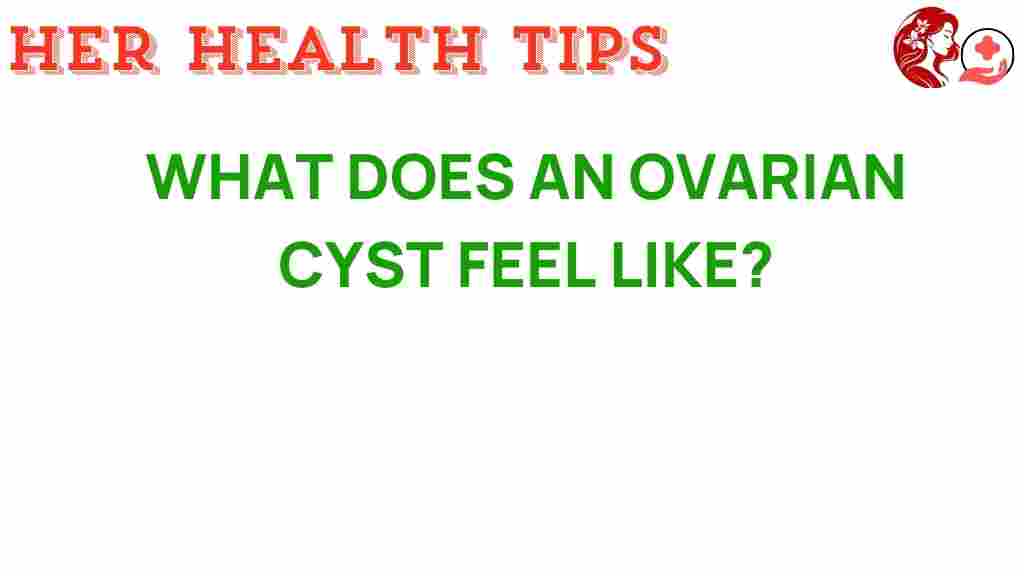Unraveling the Mystery: What Does an Ovarian Cyst Feel Like?
Ovarian cysts are fluid-filled sacs that form on the ovaries and are a common occurrence in women’s health. Understanding what an ovarian cyst feels like can help women recognize symptoms, seek appropriate diagnosis, and explore treatment options. This article aims to unravel the mystery surrounding ovarian cysts, discussing their symptoms, diagnosis, and treatments, while raising awareness about women’s reproductive health.
Understanding Ovarian Cysts
Before diving into the sensations and symptoms associated with ovarian cysts, it’s essential to understand what they are. Ovarian cysts can develop during the menstrual cycle and are usually benign. However, they can cause discomfort and lead to various complications if not monitored. Here are some key points about ovarian cysts:
- Ovarian cysts are common in women of reproductive age.
- Most cysts are harmless and resolve on their own.
- They can vary in size from tiny to several centimeters in diameter.
- Types of ovarian cysts include functional cysts, dermoid cysts, and endometriomas.
What Does an Ovarian Cyst Feel Like?
The sensations associated with ovarian cysts can vary widely among women. Some may not experience any symptoms, while others may face significant discomfort. Here are some common feelings and symptoms associated with ovarian cysts:
- Pelvic Pain: Many women report a dull ache or sharp pain in the lower abdomen. This pain can be intermittent, and may worsen during menstrual periods.
- Bloating: A feeling of fullness or swelling in the abdomen is common, especially if the cyst is large.
- Pressure: Some women may feel pressure on their bladder or rectum, leading to increased urination or difficulty with bowel movements.
- Changes in Menstrual Cycle: Irregularities in periods, such as heavier bleeding or missed periods, can occur.
- Other Symptoms: Nausea, vomiting, breast tenderness, and pain during intercourse may also accompany ovarian cysts.
Diagnosing Ovarian Cysts
Recognizing the symptoms of ovarian cysts is the first step towards diagnosis. If you suspect you have an ovarian cyst, it’s essential to consult a healthcare provider. The diagnosis typically involves:
- Medical History: Your healthcare provider will ask about your symptoms, menstrual cycle, and overall health.
- Physical Exam: A pelvic exam may be conducted to check for abnormalities.
- Imaging Tests: Ultrasounds are commonly used to visualize the cyst. In some cases, CT scans or MRIs may be necessary.
- Blood Tests: These may be performed to check hormone levels and rule out other conditions.
When to Seek Medical Attention
While many ovarian cysts are harmless, certain symptoms warrant immediate medical attention:
- Severe or sudden pelvic pain.
- Fever, vomiting, or fainting.
- Rapid breathing or shortness of breath.
If you experience any of these symptoms, it’s crucial to seek healthcare services promptly.
Treatment Options for Ovarian Cysts
The treatment for ovarian cysts largely depends on their size, type, and symptoms. Here are some common treatment options:
- Watchful Waiting: Many cysts resolve naturally without treatment. Regular monitoring may be recommended.
- Medications: Hormonal contraceptives can help regulate menstrual cycles and may prevent the formation of new cysts.
- Surgery: If a cyst is large, persistent, or suspected to be cancerous, surgical intervention may be necessary. This could involve cyst removal or, in rare cases, removal of the ovary.
Understanding the Impact on Women’s Health
Ovarian cysts can affect women’s health in various ways, both physically and emotionally. It’s essential to maintain awareness about reproductive health and understand that:
- Most ovarian cysts are benign and do not affect fertility.
- Regular gynecological check-ups can help monitor reproductive health and catch potential issues early.
- Education and awareness about ovarian cysts can lead to better management and reduced anxiety around the topic.
Troubleshooting Tips for Managing Symptoms
If you’re experiencing symptoms associated with ovarian cysts, here are some troubleshooting tips to help manage discomfort:
- Heat Therapy: Applying a heating pad to the abdomen can relieve pain and reduce cramping.
- Pain Relievers: Over-the-counter medications like ibuprofen or acetaminophen can help alleviate pain.
- Dietary Changes: Incorporating anti-inflammatory foods into your diet may help reduce symptoms.
- Regular Exercise: Engaging in regular physical activity can improve overall health and may help alleviate some symptoms.
Raising Awareness About Ovarian Cysts
Increasing awareness about ovarian cysts and their impact on women’s health is vital. Here are some ways to promote awareness:
- Education: Sharing information about ovarian cysts in community health programs.
- Support Groups: Connecting with others who experience similar symptoms can provide emotional support.
- Advocacy: Encouraging discussions about reproductive health in healthcare settings can lead to improved understanding and treatment options.
Conclusion
In conclusion, understanding what an ovarian cyst feels like is crucial for women’s health. By recognizing the symptoms, seeking a timely diagnosis, and exploring treatment options, women can take charge of their reproductive health. Awareness and education are key elements in managing ovarian cysts effectively. If you suspect you have ovarian cysts or experience discomfort, don’t hesitate to reach out to a healthcare professional.
For more information on women’s reproductive health, you can visit this resource. Additionally, stay informed and engaged with your health by exploring community health initiatives in your area.
This article is in the category Reproductive and created by HerHealthTips Team
